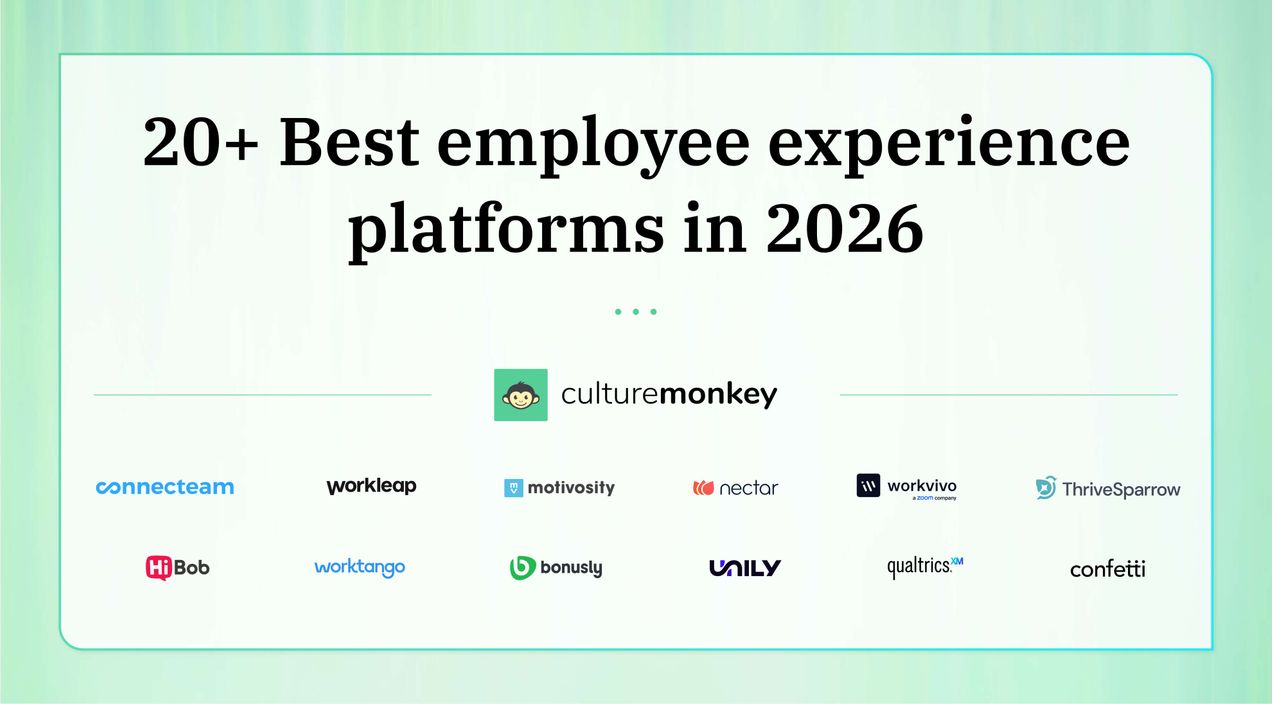What are employee relations at work: A complete guide for leaders in 2025

Think about your favorite multiplayer video game. Every player selects a role—some analyze the battlefield from a distance, planning the next move, while others charge headfirst into action. Then, there are support players who heal, defend, or provide backup to ensure the team stays strong.
Now, imagine what happens if everyone ignores the strategy and plays for themselves.. Chaos takes over, and the team loses. No matter how skilled individual players are, victory is impossible without working together.
Workplaces function the same way. Without employee relations built on trust, clear communication, and teamwork, even the most skilled individuals won’t succeed. But when employees play in sync, understand each other’s strengths, and collaborate effectively, they create a winning strategy that drives success.
So, how do you create a workplace where every player contributes to success? Let’s dive in.
Employee relations: Meaning

Employee relations refer to the efforts a company makes to manage relationships between employers and employees. It encompasses various strategies and practices aimed at employee relations refers to fostering a positive work environment, addressing grievances, and ensuring that the needs and concerns of employees are met. Effective employee relations contribute significantly to employee satisfaction, productivity, and retention.
A key aspect of positive employee relations involves open communication between management and staff. This includes regular feedback sessions, surveys, and meetings where employees can voice their opinions and suggestions.
Such interactions help in identifying and resolving issues before they escalate, thereby maintaining a harmonious workplace. Additionally, employee relations include the establishment and enforcement of workplace policies and procedures that promote fairness and equality.
Another critical component is addressing conflicts and grievances. A robust employee relations program provides mechanisms for resolving disputes, such as mediation and conflict resolution training. Using employee relations entails handling conflicts promptly and fairly, companies can prevent disruptions and maintain a cooperative work atmosphere.
What is an employee relations program?
An employee relations program is a key component of organizational strategy, designed to build trust, resolve conflicts, and create a productive work environment. It aligns employee needs with business goals, ensuring that workplace policies support both individual well-being and company growth.
These programs include structured communication channels, clear grievance-handling procedures, leadership training, and proactive engagement initiatives. They focus on compliance with labor laws, ethical workplace policies, and mechanisms for handling disputes before they escalate.
By investing in employee relations, businesses can improve morale, strengthen retention, and maintain a positive reputation. A well-executed program ensures employees are heard, valued, and motivated to contribute to the organization’s success.
Employee relations objectives

Strong employee relations are the backbone of a thriving organization, fostering a positive workplace culture that boosts productivity and employee satisfaction. The primary objectives aim to create an inclusive, engaging, and supportive environment where both employees and the organization can succeed together.
- Create a positive work environment that supports collaboration, respect, and inclusivity.
- Foster open communication between management and employees to build trust and transparency.
- Address employee concerns and feedback promptly to strengthen colleague relations and maintain harmony.
- Ensure fair treatment and equality by implementing policies that promote diversity, inclusion, and non-discrimination.
- Resolve conflicts and grievances efficiently through mediation, conflict resolution strategies, and clear communication channels.
- Enhance employee engagement and motivation by recognizing achievements, providing career development opportunities, and promoting a healthy work-life balance.
- Maintain workplace policies that align with legal requirements and organizational values to ensure fairness and consistency.
- Encourage teamwork and collaboration, creating a supportive atmosphere where employees feel valued and empowered.
- Boost overall organizational performance by fostering a workplace culture that prioritizes employee well-being and satisfaction.
Why employee relations are important?

Strong employee relations play a crucial role in maintaining a positive and productive work environment. They directly impact employee morale, retention, and overall organizational success. A well-managed employee relations strategy fosters trust, enhances teamwork, and contributes to a more engaged workforce.
When employees feel supported and valued, they are more likely to perform at their best and remain committed to the organization.
- Boosts employee satisfaction and morale: When employees feel valued and heard, they become more engaged and motivated, leading to increased productivity and job satisfaction.
- Reduces turnover rates: Addressing employee concerns promptly prevents dissatisfaction from escalating into disengagement or resignation, saving costs on recruitment and training.
- Enhances workplace culture: A positive employee relations strategy fosters a culture of fairness, inclusivity, and respect, making the organization more attractive to top talent.
- Improves conflict resolution: Clear processes for handling disputes ensure conflicts are managed effectively, minimizing workplace disruptions and maintaining harmony.
- Strengthens organizational reputation: Companies with strong employee relations are seen as fair and employee-friendly, enhancing their public image and employer brand.
What is employee relations management?

Employee relations management refers to the comprehensive approach an organization takes to maintain and build positive employee relations and improve the employer-employee relationship.
It involves a set of strategies, practices, and processes aimed at fostering a positive work environment, addressing employee concerns, and ensuring mutual respect and collaboration between management and staff. The key components of the employee relations strategy for management include:
- Communication: Establishing open and effective communication channels is vital. This involves regular feedback sessions, employee surveys, and meetings where employees can express their views and concerns. Transparent communication helps in building trust and understanding.
- Conflict resolution: Implementing mechanisms to address and resolve conflicts and grievances promptly and fairly is essential. This can include mediation, counseling, and conflict resolution training for managers and employees.
- Policy development and enforcement: Creating and enforcing workplace policies that promote fairness, equality, and compliance with labor laws is crucial. These policies should address issues such as discrimination, harassment, and employee rights.
- Employee engagement: Developing programs and initiatives to boost employee engagement and morale, such as recognition and reward systems, career development opportunities, and work-life balance initiatives, is important for maintaining a motivated workforce.
- Performance management: Implementing fair and transparent performance appraisal systems helps in setting clear expectations, providing constructive feedback, and recognizing employee contributions. This ensures that employees are aware of their roles and can work towards their goals effectively.
- Training and development: Offering continuous learning and development opportunities helps employees enhance their skills and advance their careers. This not only benefits the employees but also contributes to the organization's growth and adaptability.
9 Employee relations benefits to know in 2025

Employee relations offer numerous benefits that can significantly enhance organizational performance and employee well-being. Here are nine key benefits to know in 2025:
- Increased employee engagement: Strong employee relations foster a sense of belonging and purpose, leading to higher levels of engagement. Data shows that 59% of the world’s employees are not engaged, and 18% are actively disengaged. Engaged employees are more productive, committed, and willing to go the extra mile.
- Improved job satisfaction: When employees feel valued and heard, their job satisfaction increases. Satisfied employees are more likely to stay with the company, reducing turnover and recruitment costs.
- Enhanced communication: Effective employee relations promote open and transparent communication. This helps in building trust, preventing misunderstandings, and ensuring that everyone is aligned with organizational goals.
- Better conflict resolution: Robust employee relations provide mechanisms for addressing and resolving conflicts promptly and fairly. This minimizes disruptions and maintains a positive work environment.
- Increased productivity: A harmonious workplace with strong employee relations leads to higher productivity. Employees are more motivated and focused when they feel supported and appreciated.
- Stronger organizational culture: Employee relations contribute to a positive organizational culture that values fairness, respect, and collaboration. A strong culture attracts and retains top talent and drives overall success.
- Reduced absenteeism: When employees are satisfied and engaged, they are less likely to take unnecessary leaves. This leads to reduced absenteeism and higher overall productivity.
- Better compliance and reduced legal risks: Effective employee relations ensure that workplace policies comply with labor laws and regulations. This reduces the risk of legal issues and potential penalties.
- Enhanced employee development: A focus on employee relations includes providing opportunities for growth and development. This helps employees enhance their skills, advance their careers, and contribute more effectively to the organization.
Key skills for effective employee relations
Building strong employee relations requires a combination of interpersonal skills, legal knowledge, and strategic thinking. Leaders who master these skills can foster a positive work environment, improve workplace relations, and drive organizational success.
The following are the key skills required for effective employee relations:
- Active listening: Effective communication starts with active listening. It allows HR professionals and managers to fully understand employee concerns, needs, and feedback. By practicing active listening, leaders can strengthen work relations, reduce misunderstandings, and create a culture of trust and respect.
- Labour law knowledge: A solid understanding of labour laws is essential for maintaining compliance and protecting both the company and employees. HR employee relations specialists must be familiar with legal frameworks to ensure fair treatment, prevent disputes, and handle grievances according to established regulations.
- Emotional intelligence: Emotional intelligence is key to navigating the complexities of workplace relations. Leaders who can manage their emotions, show empathy, and understand the emotions of others are better equipped to handle conflicts and maintain a harmonious work environment.
- Negotiation skills: Strong negotiation skills are vital for resolving conflicts and reaching mutually beneficial agreements. In employment relations, skilled negotiators can bridge gaps between management and employees, fostering a collaborative environment while maintaining organizational goals.
- Problem-solving abilities: Challenges in the workplace are inevitable, making problem-solving a crucial skill. Leaders who can assess situations, identify root causes, and implement effective solutions help maintain positive employee relations and avoid recurring issues.
- Strategic thinking: Building lasting employee relations requires long-term planning and strategic thinking. Human resource professionals must align workplace relations strategies with organizational goals, ensuring that initiatives like engagement programs and conflict resolution processes contribute to overall business success.
What are the common challenges to employee relations at work?

Employee relations at work can face several common challenges that may hinder the development of a positive relationship and productive work environment. Here are some key challenges:
- Communication breakdowns: Poor communication can lead to misunderstandings, misinformation, and a lack of transparency. This can create a sense of distrust and confusion among employees, impacting morale and productivity.
- Conflict management: Conflicts are inevitable in any workplace, but without effective conflict resolution mechanisms, they can escalate and cause significant disruptions. Unresolved conflicts can lead to a toxic work environment and decreased employee satisfaction.
- Employee engagement: Keeping employees engaged and motivated is a constant challenge. Factors such as monotonous work, lack of recognition, and insufficient growth opportunities can lead to disengagement and low morale.
- Workplace diversity and inclusion: Creating a diverse and inclusive workplace where all employees feel valued and respected can be challenging. Issues such as discrimination, bias, and lack of cultural competence can hinder efforts to build an inclusive environment.
- Change management: Organizational changes, such as restructuring, mergers, or changes in leadership, can create uncertainty and anxiety among employees. Managing these transitions effectively is crucial to maintaining stability and morale.
- Balancing organizational and employee needs: Striking a balance between achieving organizational goals and addressing employee needs and concerns can be difficult. Ignoring employee well-being for the sake of productivity can lead to burnout and high turnover.
- Legal and regulatory compliance: Ensuring compliance with labor laws and regulations can be complex and time-consuming. Non-compliance can result in legal issues, financial penalties, and damage to the organization's reputation.
5 Real life examples of employee relations issues
Understanding real-life employee relations examples is essential for identifying potential challenges and implementing proactive strategies to maintain a positive workplace. The purpose of a good employee relations is to create an environment where employees feel valued, heard, and supported. Here are five detailed examples of common issues and how they can be addressed:
Conflict between team members
Imagine two employees working on a project who consistently clash due to differing work styles—one prefers structured planning while the other thrives in a fast-paced, flexible environment. This ongoing friction leads to missed deadlines and growing team tension. To resolve this, HR can facilitate mediation sessions, encourage open dialogue, and introduce team-building exercises as part of their employee relations initiatives to promote understanding and collaboration.
Workplace discrimination
An employee reports feeling excluded from meetings and projects due to their age, impacting their morale and sense of belonging. This type of age discrimination not only violates company policies but also damages workplace culture. Addressing this requires a thorough investigation, diversity training, and updating anti-discrimination policies—demonstrating the purpose of employee relations in fostering fairness and inclusion.
Employee burnout
A top-performing employee begins missing deadlines and seems disengaged. Upon closer examination, it's clear they are experiencing burnout from consistently heavy workloads and a lack of recognition. HR steps in to adjust their responsibilities, introduce flexible scheduling, and implement wellness programs—practical employee relations initiatives that support employee well-being and productivity.
Lack of communication from management
In a mid-sized company, a new policy change is implemented without informing employees, leading to confusion and frustration. Employees feel left out of decision-making processes, which affects trust and engagement. To rectify this, leadership introduces regular town halls, anonymous surveys, and transparent email communications—effective employee relations examples that build trust and keep employees informed.
Unfair treatment or favoritism
An employee notices that a colleague consistently receives high-profile projects and promotions, despite similar performance levels. Perceived favoritism undermines team morale and creates a sense of unfairness. HR intervenes by reviewing promotion criteria, standardizing performance evaluations, and training managers on unbiased decision-making—aligning with the purpose of employee relations to promote equity and transparency.
7 Employee relations best practices to try as a leader

As a leader, implementing effective employee relations practices can significantly improve employee relations and enhance workplace morale, productivity, and retention. Here are seven best practices to consider:
1. Foster open communication
Encourage a culture of open and transparent communication. Hold regular one-on-one meetings, team meetings, and feedback sessions where employees can share their ideas, concerns, and feedback. Use various communication channels to ensure everyone is informed and feels heard.
2. Recognize and reward employees
Acknowledge and celebrate employee achievements and contributions. Implement a recognition program that rewards employees for their hard work, whether through bonuses, awards, public recognition, or other incentives. This boosts morale and motivates employees to perform their best.
3. Provide opportunities for growth
Invest in employee development by offering training programs, workshops, and opportunities for career advancement. Encourage continuous learning and provide human resources, that help employees enhance their skills and grow within the organization.
4. Promote work-life balance
Support employees in maintaining a healthy work-life balance. Offer flexible working hours, remote work options, and other benefits that help employees manage their personal and professional lives effectively. This can reduce burnout and increase job satisfaction.
5. Implement fair and transparent policies
Develop and enforce clear, fair, and consistent workplace policies. Ensure that all employees understand these policies and know how to access them. Address issues such as discrimination, harassment, and workplace conduct promptly and fairly.
6. Encourage team building
Foster a sense of camaraderie and teamwork among employees. Organize team-building activities, social events, and collaborative projects that help employees build strong relationships and work effectively together. A cohesive team can improve overall productivity and workplace harmony.
7. Address conflicts promptly and fairly
Establish a clear process for addressing and resolving conflicts. Train managers and employees in conflict resolution techniques and ensure that conflicts are handled impartially and constructively. Addressing issues early can prevent them from escalating and disrupting the work environment.
25+ Employee relations activities to try at work in 2025

Here are 23+ employee relations activities to try at work in 2025 to foster a positive and engaging workplace:
- Hold weekly or bi-weekly team meetings to discuss progress, address concerns, and share updates.
- Schedule regular one-on-one meetings between managers and employees to provide personalized feedback and support.
- Conduct anonymous surveys to gather feedback on workplace satisfaction and areas for improvement.
- Implement a digital or physical suggestion box where employees can share ideas and feedback anonymously.
- Establish formal recognition programs to acknowledge employee achievements, such as Employee of the Month awards.
- Encourage employees to recognize and appreciate their colleagues' efforts through shout-outs or internal social platforms.
- Offer workshops and training sessions to help employees develop new skills and advance their careers.
- Pair employees with mentors to provide guidance, support, and career advice.
- Provide options for flexible working hours or remote work to support work-life balance.
- Implement wellness initiatives such as fitness challenges, mental health resources, and wellness workshops.
- Organize team-building exercises, such as escape rooms, group outings, or team sports events.
- Plan social events like holiday parties, happy hours, and potlucks to foster camaraderie.
- Encourage employees to participate in community service or volunteer projects together.
- Host friendly competitions or challenges, such as step challenges or cooking contests, to promote engagement.
- Offer training sessions to promote awareness and understanding of diversity and inclusion in the workplace.
- Organize informal learning sessions during lunch breaks where employees can share knowledge on various topics.
- Provide clear career pathing opportunities and help employees map out their career development plans.
- Hold open forums or town hall meetings where employees can voice their opinions and ask questions to leadership.
- Offer workshops focused on managing work-life balance, stress management, and time management.
- Support the formation of employee resource groups (ERGs) to promote networking and support among employees with shared interests or backgrounds.
- Acknowledge work anniversaries, birthdays, and personal milestones with small celebrations or messages.
- Provide stipends or reimbursement for employees to attend external training, conferences, or courses.
- Regularly update employees on company performance, goals, and changes to foster a culture of transparency and trust.
- Offer training sessions on conflict resolution skills for both employees and managers.
- Encourage an open-door policy where employees feel comfortable approaching leadership with concerns or suggestions.
- Dedicate a day to show appreciation for employees with activities, gifts, or special events.
- Celebrate a variety of cultural holidays and events to promote inclusivity and respect for diversity.
- Utilize tools that allow employees to provide anonymous feedback on various aspects of the workplace.
- Encourage collaboration across departments on special projects to build interdepartmental relationships.
- Conduct regular training on workplace health and safety to ensure a safe working environment.
How to handle employee relations issues as a leader the right way?

Handling employee relations issues effectively as a leader requires a balanced approach centered on communication, fairness, and proactive problem-solving. The first step for an employee relations manager is to foster a positive work environment where open communication is encouraged.
Regular check-ins and an open-door policy can help identify potential issues early, allowing leaders to address concerns before they escalate. When an issue arises, it’s crucial to listen actively and empathetically to all parties involved.
This means giving employees the space to express their concerns without interruption, acknowledging their feelings, and demonstrating understanding. Gathering all relevant facts through a thorough investigation is essential to ensure a fair assessment of the situation.
Maintaining confidentiality throughout the process is key to preserving trust. Leaders should develop a clear action plan in collaboration with the HR department and other relevant parties, setting specific objectives for resolution and communicating these steps transparently to those involved.
Prompt action is necessary to implement the solution effectively, followed by regular follow-ups to ensure the issue is resolved and no further problems emerge.
Documentation of all steps taken is vital for accountability and future reference. Finally, evaluating the outcome and learning from the experience can help improve future handling of employee relations issues, contributing to a healthier workplace.
The essential role of an employee relations manager
An employee relations manager plays a critical role in fostering a positive and productive work environment by bridging the gap between management and employees. Their primary responsibility is to implement strategies that promote healthy colleague relations, resolve workplace conflicts, and ensure that company policies align with legal standards and employee needs. By leading the employee relations program, they help maintain employee satisfaction, engagement, and overall organizational success.
The employee relations manager role involves overseeing various aspects of workplace dynamics, ensuring that employees feel heard, respected, and treated fairly. They act as a mediator in disputes, a strategist in enhancing workplace culture, and a compliance officer ensuring adherence to labor laws. By focusing on HR employee relations, they support both management and staff in maintaining a harmonious work environment.
Key responsibilities of an employee relations manager:
- Develop and implement comprehensive employee relations programs to improve workplace culture.
- Mediate conflicts between employees and management to foster positive colleague relations.
- Ensure compliance with labor laws, company policies, and HR best practices.
- Conduct workplace investigations related to grievances, discrimination, or harassment.
- Facilitate training on conflict resolution, diversity, and company policies.
- Analyze employee feedback and survey data to identify areas for improvement.
- Support management in developing strategies that align business goals with employee satisfaction.
7 Employee relations examples to get inspiration from

Here are seven examples of effective employee relations efforts that can inspire leaders and organizations:
- Cross-departmental collaboration projects: Encouraging employees from different departments to collaborate on projects promotes teamwork, breaks down silos, and enhances communication across the organization.
- Reverse mentoring programs: Implementing programs where younger or newer employees mentor senior employees in areas like technology or cultural trends can foster mutual learning and bridge generational gaps.
- Job rotation opportunities: Offering job rotation or job shadowing opportunities allows employees to gain exposure to different roles within the company, fostering career development and creating a positive company culture and skills diversity.
- Wellness challenges and competitions: Organizing friendly competitions or challenges focused on wellness goals, such as step challenges or healthy eating competitions, promotes camaraderie and encourages healthy habits.
- Employee-led learning sessions: Facilitating sessions where employees can share their expertise or hobbies with colleagues, such as lunch-and-learn sessions or skill-sharing workshops, promotes a culture of continuous learning and collaboration.
- Virtual team-building activities: Creating virtual team-building activities, such as online games, virtual escape rooms, or themed virtual parties, helps remote teams bond and build positive relationships despite physical distance.
- Community engagement initiatives: Encouraging employees to participate in community service or volunteering activities as a team strengthens the company’s social responsibility efforts and fosters a sense of pride and purpose among employees.
Significance of conducting employee relation survey at work

Employee relations surveys are a valuable tool for organizations to assess workplace dynamics and improve employee engagement. They provide critical insights into the relationship between management and employees, helping to create a more positive and productive work environment.
- Evaluates employee engagement and morale: Surveys help measure job satisfaction, workload balance, recognition, and communication, identifying factors that impact employee motivation and retention.
- Facilitates open communication: By allowing employees to share feedback anonymously, surveys encourage honest responses, fostering a culture of trust and transparency within the organization.
- Identifies workplace challenges: These surveys highlight potential concerns related to policies, management effectiveness, or company culture, helping organizations address issues before they escalate.
- Supports continuous improvement: Regular surveys track progress over time, enabling data-driven decisions that refine human resource management and enhance employee relations programs.
- Strengthens workplace culture: Understanding employee concerns and acting on feedback demonstrates leadership’s commitment to employee well-being, boosting satisfaction and overall workplace harmony.
35+ Employee relation survey questions to ask in 2025
Creating an effective employee relations survey requires a mix of questions that cover various aspects of the work environment, management practices, job satisfaction, and employee well-being. Here are 35+ examples of employee relations survey questions to consider for 2025:
- How satisfied are you with your current job role?
- Do you feel valued and recognized for your work?
- How well do your job responsibilities match your skills and interests?
- Are you satisfied with the level of autonomy in your job?
- How would you rate the overall work environment at our company?
- Do you feel safe and comfortable in your workplace?
- Are the tools and resources provided sufficient to perform your job effectively?
- How satisfied are you with the physical working conditions (e.g., office space, equipment)?
- Do you feel that management communicates effectively with employees?
- How approachable and supportive do you find your immediate supervisor?
- Do you receive constructive feedback regularly?
- How well does management handle employee concerns and grievances?
- Are you kept informed about important company updates and changes?
- Do you feel comfortable sharing your ideas and suggestions?
- How would you rate the effectiveness of communication within your team?
- Are there adequate opportunities for professional growth and development?
- Do you receive the necessary training to perform your job well?
- Are you satisfied with the career advancement opportunities available to you?
- How satisfied are you with your work-life balance?
- Do you feel that the company supports your efforts to maintain a healthy work-life balance?
- Are flexible work arrangements available and sufficient to meet your needs?
- Do you feel engaged and motivated in your work?
- Do you find your work meaningful and rewarding?
- How likely are you to recommend this company as a great place to work?
- Do you feel that the company values diversity and inclusion?
- Are all employees treated fairly and with respect?
- Have you experienced or witnessed any form of discrimination or bias at work?
- How well do team members collaborate and support each other?
- Do you feel that your team works effectively together to achieve goals?
- Are conflicts within your team resolved fairly and promptly?
- How satisfied are you with your overall compensation package?
- Are the benefits provided by the company sufficient to meet your needs?
- Do you feel that your compensation is competitive compared to similar roles in other companies?
- Do you feel secure in your job position?
- Are you confident in the company’s future and your role within it?
- What do you like most about working here?
- What areas do you think need improvement?
- Do you have any suggestions for enhancing employee relations at our company?
- Is there anything else you would like to share about your experience working here?
Conclusion
Strong employee relations are the foundation of a thriving workplace, where employees feel valued, engaged, and motivated to contribute their best. Organizations that prioritize employee connection foster a culture of trust, collaboration, and mutual respect, leading to higher productivity, reduced turnover, and a more positive work environment.
When employees feel heard and supported, they are more likely to be committed to their roles and aligned with company goals. Building meaningful employee connections requires ongoing effort, proactive communication, and data-driven decision-making. This is where CultureMonkey plays a crucial role.
As an employee engagement platform, CultureMonkey helps organizations gather real-time feedback through anonymous surveys, providing critical insights into employee sentiment and workplace challenges. With AI-driven analytics, HR teams and leaders can identify trends, measure engagement, and take timely action to improve employee relations.
By leveraging tools like CultureMonkey, companies can create a culture that values employee voices, strengthens workplace connections, and fosters long-term success. Investing in employee relations isn’t just beneficial for individuals—it’s a strategic move that drives overall business growth and sustainability.
FAQ
1. What is the meaning of employee relations?
Employee relations refers to the efforts an organization makes to build and maintain a positive relationship between employers and employees. It involves fostering open communication, addressing workplace concerns, ensuring fair treatment, and promoting a supportive work environment. Strong employee relations enhance engagement, job satisfaction, and overall organizational success by creating a culture of trust and collaboration.
2. What is the difference between HR and employee relations?
HR (Human Resources) manages hiring, payroll, benefits, compliance, and workforce strategy. Employee relations, a key HR function, focuses on workplace culture, conflict resolution, fair treatment, and engagement. While HR covers broad workforce needs, employee relations nurtures employer-employee relationships, resolves disputes, prevents legal issues, improves communication, and ensures a supportive, productive, and legally compliant work environment.
3. What is the role of HR in employee relations?
HR plays a crucial role in employee relations by fostering a positive work environment, ensuring compliance with labor laws, resolving conflicts, and promoting fair treatment. HR also develops engagement programs, manages grievances, facilitates communication, implements workplace policies, supports leadership, enhances job satisfaction, prevents legal issues, improves retention, boosts employee morale, and ensures a collaborative, inclusive, and legally compliant organizational culture.
4. Is employee relations a skill?
Yes, employee relations is a skill that involves managing workplace relationships, resolving conflicts, and fostering a positive environment. It requires strong communication, problem-solving, negotiation, emotional intelligence, and strategic thinking. Professionals skilled in employee relations enhance engagement, improve team dynamics, ensure fair treatment, support compliance, boost morale, strengthen company culture, and contribute to a productive, legally compliant workplace.
5. What is another name for employee relations?
Another name for employee relations is workplace relations, labor relations, or colleague relations. It involves fostering positive interactions between employees and management, resolving conflicts, ensuring labor law compliance, and enhancing workplace culture. When comparing employee relations vs employee engagement, relations focus on structure and policies, while engagement is about driving enthusiasm, productivity, and emotional investment in work.
6. What is the difference between HR and IR?
HR (Human Resources) focuses on managing workforce functions like hiring, payroll, training, compliance, and employee engagement. IR (Industrial Relations) deals with employer-employee relationships, labor laws, union negotiations, and dispute resolution. While HR oversees workforce management, IR ensures legal compliance, fair labor practices, and collective bargaining. Understanding employee relations meaning helps businesses maintain workplace harmony and effective labor management.



